Entry Database : PDB / ID : 3cs8Title Structural and Biochemical Basis for the Binding Selectivity of PPARg to PGC-1a PGC-1alfa peptide Peroxisome proliferator-activated receptor gamma Keywords / / / / / / / / / / / / / / / / Function / homology Function Domain/homology Component
/ / / / / / / / / / / / / / / / / / / / / / / / / / / / / / / / / / / / / / / / / / / / / / / / / / / / / / / / / / / / / / / / / / / / / / / / / / / / / / / / / / / / / / / / / / / / / / / / / / / / / / / / / / / / / / / / / / / / / / / / / / / / / / / / / / / / / / / / / / / / / / / / / / / Biological species Homo sapiens (human)Method / / / Resolution : 2.3 Å Authors Li, Y. / Martynowski, D. Journal : J.Biol.Chem. / Year : 2008Title : Structural and biochemical basis for the binding selectivity of peroxisome proliferator-activated receptor gamma to PGC-1alpha.Authors : Li, Y. / Kovach, A. / Suino-Powell, K. / Martynowski, D. / Xu, H.E. History Deposition Apr 9, 2008 Deposition site / Processing site Revision 1.0 Jun 3, 2008 Provider / Type Revision 1.1 Jul 13, 2011 Group Revision 1.2 Feb 21, 2024 Group / Database references / Derived calculationsCategory chem_comp_atom / chem_comp_bond ... chem_comp_atom / chem_comp_bond / database_2 / struct_ref_seq_dif / struct_site Item _database_2.pdbx_DOI / _database_2.pdbx_database_accession ... _database_2.pdbx_DOI / _database_2.pdbx_database_accession / _struct_ref_seq_dif.details / _struct_site.pdbx_auth_asym_id / _struct_site.pdbx_auth_comp_id / _struct_site.pdbx_auth_seq_id
Show all Show less
 Yorodumi
Yorodumi Open data
Open data Basic information
Basic information Components
Components Keywords
Keywords Function and homology information
Function and homology information Homo sapiens (human)
Homo sapiens (human) X-RAY DIFFRACTION /
X-RAY DIFFRACTION /  SYNCHROTRON /
SYNCHROTRON /  MOLECULAR REPLACEMENT / Resolution: 2.3 Å
MOLECULAR REPLACEMENT / Resolution: 2.3 Å  Authors
Authors Citation
Citation Journal: J.Biol.Chem. / Year: 2008
Journal: J.Biol.Chem. / Year: 2008 Structure visualization
Structure visualization Molmil
Molmil Jmol/JSmol
Jmol/JSmol Downloads & links
Downloads & links Download
Download 3cs8.cif.gz
3cs8.cif.gz PDBx/mmCIF format
PDBx/mmCIF format pdb3cs8.ent.gz
pdb3cs8.ent.gz PDB format
PDB format 3cs8.json.gz
3cs8.json.gz PDBx/mmJSON format
PDBx/mmJSON format Other downloads
Other downloads 3cs8_validation.pdf.gz
3cs8_validation.pdf.gz wwPDB validaton report
wwPDB validaton report 3cs8_full_validation.pdf.gz
3cs8_full_validation.pdf.gz 3cs8_validation.xml.gz
3cs8_validation.xml.gz 3cs8_validation.cif.gz
3cs8_validation.cif.gz https://data.pdbj.org/pub/pdb/validation_reports/cs/3cs8
https://data.pdbj.org/pub/pdb/validation_reports/cs/3cs8 ftp://data.pdbj.org/pub/pdb/validation_reports/cs/3cs8
ftp://data.pdbj.org/pub/pdb/validation_reports/cs/3cs8 Links
Links Assembly
Assembly
 Components
Components Homo sapiens (human) / Gene: PPARGC1A, LEM6, PGC1, PGC1A, PPARGC1 / Plasmid: pETDuet1 / Production host:
Homo sapiens (human) / Gene: PPARGC1A, LEM6, PGC1, PGC1A, PPARGC1 / Plasmid: pETDuet1 / Production host: 
 X-RAY DIFFRACTION / Number of used crystals: 1
X-RAY DIFFRACTION / Number of used crystals: 1  Sample preparation
Sample preparation SYNCHROTRON / Site:
SYNCHROTRON / Site:  APS
APS  / Beamline: 32-ID / Wavelength: 0.9798 Å
/ Beamline: 32-ID / Wavelength: 0.9798 Å Processing
Processing MOLECULAR REPLACEMENT / Resolution: 2.3→24.57 Å / Cor.coef. Fo:Fc: 0.924 / Cor.coef. Fo:Fc free: 0.883 / SU B: 7.672 / SU ML: 0.189 / Cross valid method: THROUGHOUT / ESU R: 0.398 / ESU R Free: 0.276 / Stereochemistry target values: MAXIMUM LIKELIHOOD / Details: HYDROGENS HAVE BEEN ADDED IN THE RIDING POSITIONS
MOLECULAR REPLACEMENT / Resolution: 2.3→24.57 Å / Cor.coef. Fo:Fc: 0.924 / Cor.coef. Fo:Fc free: 0.883 / SU B: 7.672 / SU ML: 0.189 / Cross valid method: THROUGHOUT / ESU R: 0.398 / ESU R Free: 0.276 / Stereochemistry target values: MAXIMUM LIKELIHOOD / Details: HYDROGENS HAVE BEEN ADDED IN THE RIDING POSITIONS Movie
Movie Controller
Controller


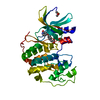
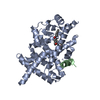
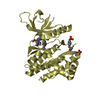
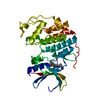
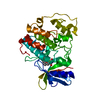

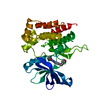

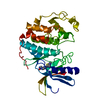
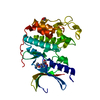
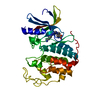
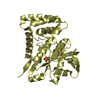
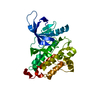

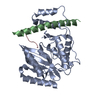
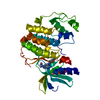
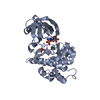
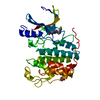

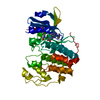
 PDBj
PDBj












